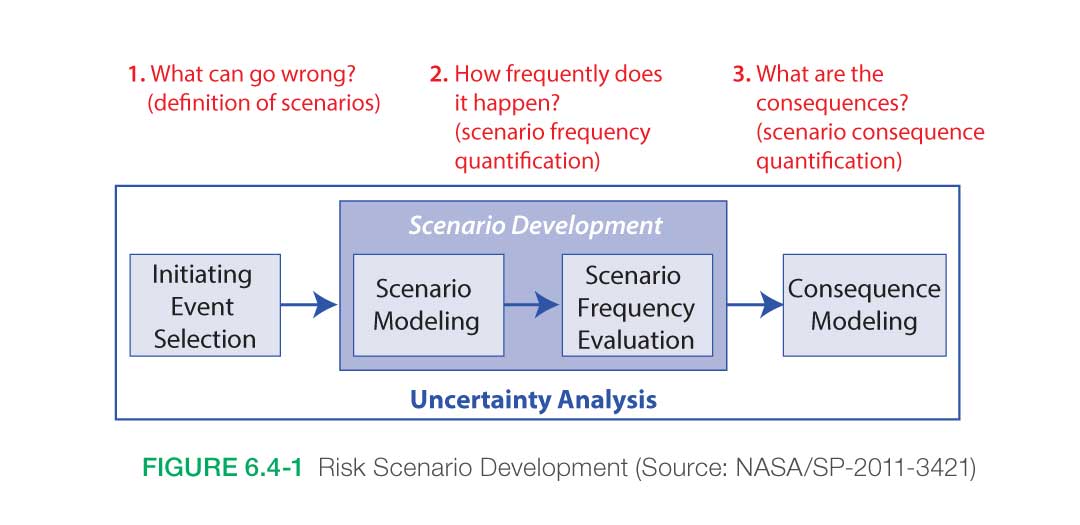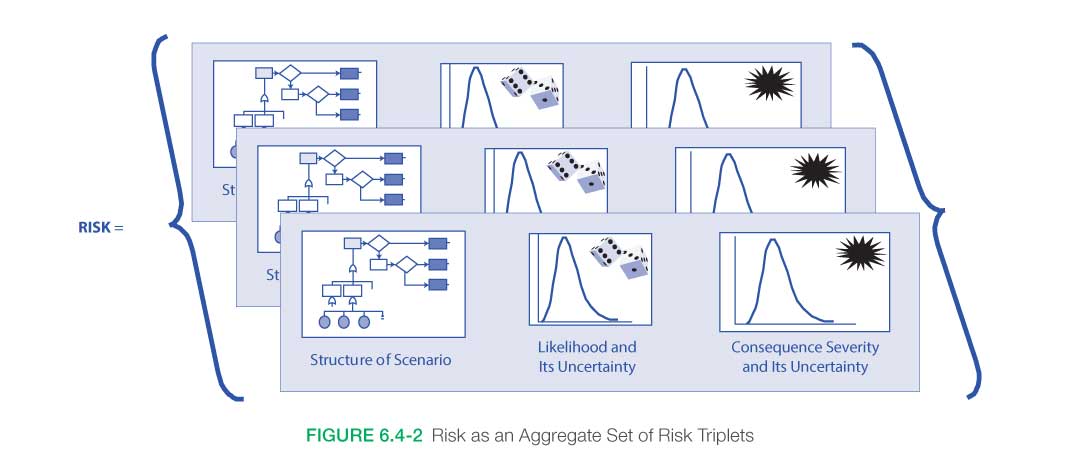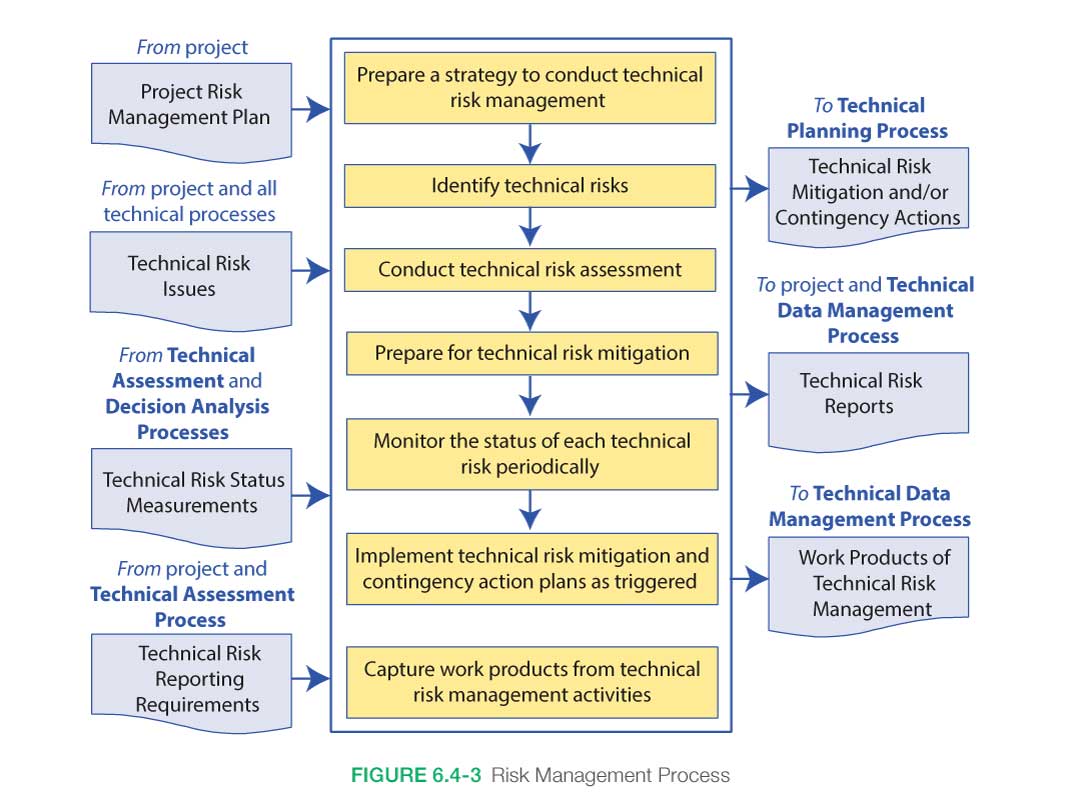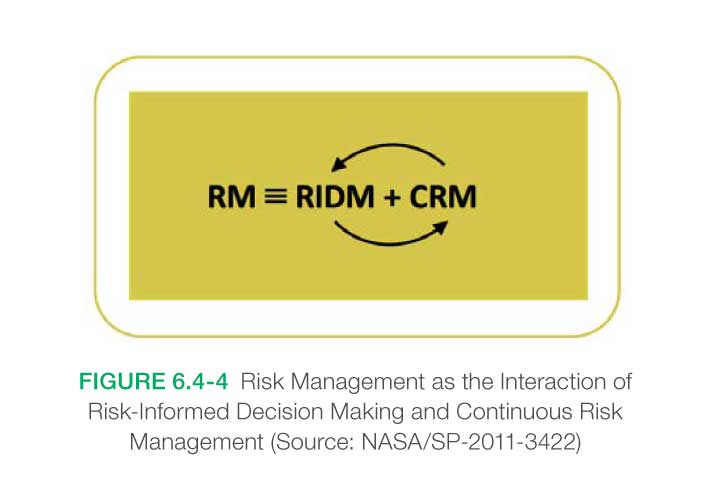6.1 Technical Planning
6.2 Requirements Management
6.3 Interface Management
6.4 Technical Risk Management
6.5 Configuration Management
6.6 Technical Data Management
6.7 Technical Assessment
6.8 Decision Analysis
The Technical Risk Management Process is one of the crosscutting technical management processes. Risk is the potential for performance shortfalls, which may be realized in the future, with respect to achieving explicitly established and stated performance requirements. The performance shortfalls may be related to institutional support for mission execution or related to any one or more of the following mission execution domains:
- safety
- technical
- cost
- schedule
Systems engineers are involved in this process to help identify potential technical risks, develop mitigation plans, monitor progress of the technical effort to determine if new risks arise or old risks can be retired, and to be available to answer questions and resolve issues. The following is guidance in implementation of risk management in general. Thus, when implementing risk management on any given program/project, the responsible systems engineer should direct the effort accordingly. This may involve more or less rigor and formality than that specified in governing documents such as NPRs. Of course, if deviating from NPR “requirements,” the responsible engineer must follow the deviation approval process. The idea is to tailor the risk management process so that it meets the needs of the individual program/project being executed while working within the bounds of the governing documentation (e.g., NPRs). For detailed information on the Risk Management Process, refer to the NASA Risk Management Handbook (NASA/SP-2011-3422).
Risk is characterized by three basic components:
- The scenario(s) leading to degraded performance with respect to one or more performance measures (e.g., scenarios leading to injury, fatality, destruction of key assets; scenarios leading to exceedance of mass limits; scenarios leading to cost overruns; scenarios leading to schedule slippage);
- The likelihood(s) (qualitative or quantitative) of those scenario(s); and
- The consequence(s) (qualitative or quantitative severity of the performance degradation) that would result if the scenario(s) was (were) to occur.
Uncertainties are included in the evaluation of likelihoods and consequences.
Scenarios begin with a set of initiating events that cause the activity to depart from its intended state. For each initiating event, other events that are relevant to the evolution of the scenario may (or may not) occur and may have either a mitigating or exacerbating effect on the scenario progression. The frequencies of scenarios with undesired consequences are determined. Finally, the multitude of such scenarios is put together, with an understanding of the uncertainties, to create the risk profile of the system.
This “risk triplet” conceptualization of risk is illustrated in Figures 6.4-1 and 6.4-2.
Undesired scenario(s) might come from technical or programmatic sources (e.g., a cost overrun, schedule slippage, safety mishap, health problem, malicious activities, environmental impact, or failure to achieve a needed scientific or technological objective or success criterion). Both the likelihood and consequences may have associated uncertainties.
Key Concepts in Risk Management
Risk: Risk is the potential for shortfalls, which may be realized in the future with respect to achieving explicitly-stated requirements. The performance shortfalls may be related to institutional support for mission execution, or related to any one or more of the following mission execution domains: safety, technical, cost, schedule. Risk is characterized as a set of triplets:
- The scenario(s) leading to degraded performance in one or more performance measures.
- The likelihood(s) of those scenarios.
- The consequence(s), impact, or severity of the impact on performance that would result if those scenarios were to occur.
Uncertainties are included in the evaluation of likelihoods and consequences.
Cost Risk: This is the risk associated with the ability of the program/project to achieve its life-cycle cost objectives and secure appropriate funding. Two risk areas bearing on cost are (1) the risk that the cost estimates and objectives are not accurate and reasonable; and (2) the risk that program execution will not meet the cost objectives as a result of a failure to handle cost, schedule, and performance risks.
Schedule Risk: Schedule risks are those associated with the adequacy of the time estimated and allocated for the development, production, implementation, and operation of the system. Two risk areas bearing on schedule risk are (1) the risk that the schedule estimates and objectives are not realistic and reasonable; and (2) the risk that program execution will fall short of the schedule objectives as a result of failure to handle cost, schedule, or performance risks.
Technical Risk: This is the risk associated with the evolution of the design and the production of the system of interest affecting the level of performance necessary to meet the stakeholder expectations and technical requirements. The design, test, and production processes (process risk) influence the technical risk and the nature of the product as depicted in the various levels of the PBS (product risk).
Programmatic Risk: This is the risk associated with action or inaction from outside the project, over which the project manager has no control, but which may have significant impact on the project. These impacts may manifest themselves in terms of technical, cost, and/or schedule. This includes such activities as: International Traffic in Arms Regulations (ITAR), import/export control, partner agreements with other domestic or foreign organizations, congressional direction or earmarks, Office of Management and Budget (OMB) direction, industrial contractor restructuring, external organizational changes, etc.
Scenario: A sequence of credible events that specifies the evolution of a system or process from a given state to a future state. In the context of risk management, scenarios are used to identify the ways in which a system or process in its current state can evolve to an undesirable state.
6.4.1 Risk Management Process Description
Figure 6.4-3 provides a typical flow diagram for the Risk Management Process and identifies typical inputs, activities, and outputs to consider in addressing risk management.
6.4.1.1 Inputs
The following are typical inputs to risk management:
- Project Risk Management Plan: The Risk Management Plan is developed under the Technical Planning Process and defines how risk will be identified, mitigated, monitored, and controlled within the project.
- Technical Risk Issues: These will be the technical issues identified as the project progresses that pose a risk to the successful accomplishment of the project mission/goals.
- Technical Risk Status Measurements: These are any measures that are established that help to monitor and report the status of project technical risks.
- Technical Risk Reporting Requirements: Includes requirements of how technical risks will be reported, how often, and to whom.
Additional inputs that may be useful:
- Other Plans and Policies: Systems Engineering Management Plan, form of technical data products, and policy input to metrics and thresholds.
- Technical Inputs: Stakeholder expectations, concept of operations, imposed constraints, tracked observables, current program baseline, performance requirements, and relevant experience data.
6.4.1.2 Activities
6.4.1.2.1 Prepare a Strategy to Conduct Technical Risk Management
This strategy would include documenting how the program/project risk management plan (as developed during the Technical Planning Process) will be implemented, identifying any additional technical risk sources and categories not captured in the plan, identifying what will trigger actions and how these activities will be communicated to the internal and external teams.
6.4.1.2.2 Identify Technical Risks
On a continuing basis, the technical team will identify technical risks including their source, analyze the potential consequence and likelihood of the risks occurring, and prepare clear risk statements for entry into the program/project risk management system. Coordination with the relevant stakeholders for the identified risks is included. For more information on identifying technical risks, see Section 6.4.2.1.
6.4.1.2.3 Conduct Technical Risk Assessment
Until recently, NASA’s Risk Management (RM) approach was based almost exclusively on Continuous Risk Management (CRM), which stresses the management of individual risk issues during implementation. In December of 2008, NASA revised its RM approach in order to more effectively foster proactive risk management. The new approach, which is outlined in NPR 8000.4, Agency Risk Management Procedural Requirements and further developed in NASA/SP-2011-3422, NASA Risk Management Handbook, evolves NASA‘s risk management to entail two complementary processes: Risk-Informed Decision Making (RIDM) and CRM. RIDM is intended to inform direction-setting systems engineering (SE) decisions (e.g., design decisions) through better use of risk and uncertainty information in selecting alternatives and establishing baseline performance requirements (for additional RIDM technical information, guidance, and process description, see NASA/SP-2010-576 Version 1, NASA Risk-Informed Decision Making Handbook).
CRM is then used to manage risks over the course of the development and implementation phases of the life cycle to assure that requirements related to safety, technical, cost, and schedule are met. In the past, RM was considered equivalent to the CRM process; now, RM is defined as comprising both the RIDM and CRM processes, which work together to assure proactive risk management as NASA programs and projects are conceived, developed, and executed. Figure 6.4-4 illustrates the concept.
6.4.1.2.4 Prepare for Technical Risk Mitigation
This includes selecting the risks that will be mitigated and more closely monitored, identifying the risk level or threshold that will trigger a risk mitigation action plan, and identifying for each risk which stakeholders will need to be informed that a mitigation/contingency action is determined as well as which organizations will need to become involved to perform the mitigation/contingency action.
6.4.1.2.5 Monitor the Status of Each Technical Risk Periodically
Risk status will need to be monitored periodically at a frequency identified in the risk plan. Risks that are approaching the trigger thresholds will be monitored on a more frequent basis. Reports of the status are made to the appropriate program/project management or board for communication and for decisions whether to trigger a mitigation action early. Risk status will also be reported at most life cycle reviews.
6.4.1.2.6 Implement Technical Risk Mitigation and Contingency Action Plans as Triggered
When the applicable thresholds are triggered, the technical risk mitigation and contingency action plans are implemented. This includes monitoring the results of the action plan implementation and modifying them as necessary, continuing the mitigation until the residual risk and/or consequence impacts are acceptable, and communicating the actions and results to the identified stakeholders. Action plan reports are prepared and results reported at appropriate boards and at life cycle reviews.
6.4.1.2.7 Capture Work Products
Work products include the strategy and procedures for conducting technical risk management; the rationale for decisions made; assumptions made in prioritizing, handling, and reporting technical risks and action plan effectiveness; actions taken to correct action plan implementation anomalies; and lessons learned.
6.4.1.3 Outputs
Following are key risk outputs from activities:
- Technical Risk Mitigation and/or Contingency Actions: Actions taken to mitigate identified risks or contingency actions taken in case risks are realized.
- Technical Risk Reports: Reports of the technical risk policies, status, remaining residual risks, actions taken, etc. Output at the agreed-to frequency and recipients.
- Work Products: Includes the procedures for conducting technical risk management; rationale for decisions made; selected decision alternatives; assumptions made in prioritizing, handling, and reporting technical risks; and lessons learned.
6.4.2 Risk Management Process Guidance
For additional guidance on risk management, refer to NASA/SP-2010-576, NASA RIDM Handbook and NASA/SP-2011-3422, NASA Risk Management Handbook.



























